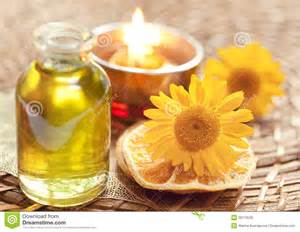





When the combination is more than the sum of the parts, there is a synergistic effect. By mixing together two or more essential oils you are creating a chemical compound that is different to any of the component parts, and these synergistic blends are very particular and powerful.
An increased potency can be achieved with a synergistic blends without increasing the dosage. For example, the anti-inflammatory action of chamomile essential oil is greatly increased by adding lavender in the correct proportion.
The interaction of particular essential oils upon each other gives a vibrancy and dynamism to the whole which could not be achieved by using a single component on its own.
The important point about synergistic blends is that the proportions should be correct, and sometimes it is necessary to make up more in volume than you need to use so that the smallest component oils can be incorporated into the whole in the right proportion. Diluted in a body oil, you may have a component part which is only 0.001 per cent of the whole - and yet that minuscule amount is integral to the whole.
Adaptogens
There are several essential oils that act as natural balancers/ These adaptogens as they are called, will instigate a reaction in the body that is appropriate to achieve a state of homeostatis or balance. The reactions affect the autonomic nervous system, the endocrine system and blood pressure; among others.
For example, hyssop normalises either high or low blood pressure so that the equilibrium is achieved.
Lemon works on the autonomic nervous system, acting as a sedative when needed, or as a tonic. Peppermint is another oil that could be found listed on both 'relaxant ' and 'stimulant' lists, and this apparent contradiction can cause confusion unless you understand that these are adaptogens. Interestingly, there are other natural products that fall into the same group which have been researched by scientists in Vladivostock, USSR, among them the herb mint and the root ginseng.
Chemotypes
The same species of plants can produce essential oils with different chemical components, when grown in various conditions. For example, the common herb Thymus Officinalis produces several oils for medicinal use, depending upon the soil, climate and altitude in which it was cultivated.
Thyme linalol, which is usually grown at high altitudes, is the oil chemotype of thyme that can be used in the treatment of children. Because one species of oil-producing, plant can break down into several chemotypes, each with different medical potentials, the list of useful plants is more extensive than first appearances might imply.
Reference: Fragrant Pharmacy/Valerie A. Worwood
- Home
- Vaginal infections and inflammation
- Threat to the Forests
- The Vinegar treatment for Thrush
- Treating Acid Environments
- Your Basic Travel Kit - Tummy Troubles
- Pamela L. Crowell on the Prevention and Therapy of Cancer by Dietary Monoterpenes
- Thrush (Candida) Case History
- Problems In Pregnancy
- The Work of Anne-Marie Giraud-Robert
- Thrush treatment for Men- Women
- Applications For Your Basic Care Kit - 4
- Fragrant Pharmacy
- Bites and Stings - General Action - Your Basic Travel Kit
- Whooping Cough
- Lymphoedema
- The journey
- Your Basic Travel Kit - Fevers
- Applications For Your Basic Care Kit - 3
- Your Basic Travel Kit - The Heat
- Aromatherapy-Cramps
- Aromatherapy-Articles-A-Z
- Verrucas and Warts
- Rabid Bites and Scratches - Your Basic Travel Kit
- Your Basic Travel Kit
- Wrinkles and Ageing Skin - Facial Scrubs
- Wrinkles and Ageing Skin - Cleansers
- Wrinkles and the Ageing Skin
- Fragrant way to Beauty - 2
- The Fragrant way to Beauty
- A-Z of Dance and Sports Injuries - 7
- A-Z of Dance and Sports Injuries - 6
- A-Z of Dance and Sports Injuries - 5
- A-Z of Sports and Dance Injuries - 4
- A-Z of Sports and Dance Injuries-3
- A-Z of Sports and Dance Injuries-2
- A-Z of Sports and Dance Injuries
- Aromatherapy - Locker Room Scents
- Aromatherapy- Stress & Sports - Jacuzzis
- Aromatherapy-stress & Sport - Saunas
- Aromatherapy - stress & Sport - Showers
- Stress and Sport - Aromatherapy
- Foot Care - 2 - Aromatherapy
- Foot Care - Aromatherapy
- MUSCLES-Aromatherapy
We have 81 guests and no members online

